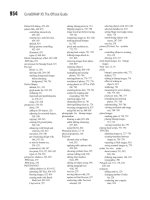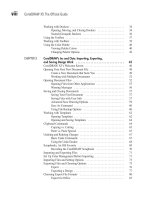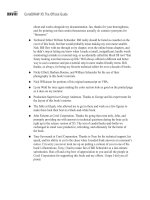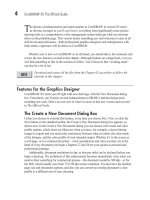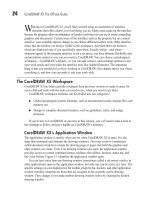CorelDRAW X5 The Official Guide part 30 ppsx
Bạn đang xem bản rút gọn của tài liệu. Xem và tải ngay bản đầy đủ của tài liệu tại đây (329.52 KB, 10 trang )
option is not selected, new values you set for absolute, nonrelative position move an object
to the absolute location shown on your current ruler position.
Rotating Objects
With Rotate, you can make multiple copies, and enter exact angles of rotation based on
degrees and in default increments of 5 using the spin boxes. Figure 9-10 shows two very
different results when using relative and absolute positioning and making two copies of the
teakettle.
Entering negative values rotates an object clockwise, while positive values cause
counterclockwise rotation. Selecting the Relative Center option allows either Vertical or
Horizontal to rotate objects, according to the object’s center marker position, and the
position of that is specified as either V or H. You can specify a new center origin position for
your object’s rotation by changing the existing value in the H and V boxes. When Relative
Center is not selected, your object is rotated according to the page center.
Scale and Mirror Objects
The Scale and Mirror transformation has features for entering precise changes in object size.
You can also cause the object to be flipped either V or H, and/or simultaneously, by clicking
one of the two mirror buttons, as shown in Figure 9-11.
When the Proportional option is unchecked, your object’s new horizontal and vertical
scale values are unlinked, meaning you can apply scaling commands to either the width
or height, independent of each other. While the Proportional option is checked, width and
height scaling operations are locked to each other. This means that scaling the width
or height by a given percentage value causes the adjacent value to be calculated automatically
to preserve your selected object’s original proportions.
254 CorelDRAW X5 The Official Guide
FIGURE 9-9 This object was precisely moved by applying a Position transformation.
Original position New position
Object moved 2 inches
CHAPTER 9: Moving, Scaling, Rotating: Basic Transformations 255
9
FIGURE 9-10 The Rotation transformation features an offset option when you choose Relative
positioning for duplicates of the original object.
FIGURE 9-11 Both Scale and Mirror changes were applied to the drawing.
Original object shape
New object scaled 50 percent
and mirrored horizontally
Sizing Objects
This transformation type gives you the option to change either the V and/or H measure of an
object selection based on the values entered. For example, entering 2 inches in the H box
and clicking the Apply button causes the selected object to be scaled to a width of 2 inches.
When the Proportional option is unchecked, the width and height values can be changed
independently. While the Proportional option is selected, width and height values are linked
and calculated automatically to alter the size of the object proportionally.
Precision Skewing
The term skew means to change the position of two sides of a shape in a parallel fashion
while leaving the other two sides alone; slanting is a more common term for “skew.” The
Skew transformation also gives you the chance to apply both vertical and horizontal skew
independently or simultaneously by entering degree measures, in turn, transforming the
object either V or H. As with rotation commands, negative degree values cause clockwise
skews, while positive values cause counterclockwise skews. Choosing the Use Anchor Point
option enables you to specify left, center, right, top, bottom, sides, or corner points as the
point around which your objects are skewed, as shown in Figure 9-12. The skewed copy
more or less looks like a cast shadow of the original symbol, doesn’t it?
256 CorelDRAW X5 The Official Guide
FIGURE 9-12 A precision Skew changes both the angle and the size of this object in a single
command.
Object horizontally skewed 45
degrees using bottom-right origin
Original object
Controlling the Order of Things
How your objects are ordered is another consideration when organizing drawing objects in a
composition. The order of objects determines whether an object appears in front of—or
behind—another object. Your page and the pasteboard (the area surrounding your document
page) are always the backmost point, while your screen is always the frontmost point. All
objects are layered between these two points.
When overlapping objects are ordered, they appear in front of or behind each other,
according to their order. As you create each new object, it is put in front of all existing
objects on the current document layer. Changing the object order lets you rearrange
overlapping objects without changing their position on the page. To do this, CorelDRAW
has a series of order commands that let you shuffle the order of objects in various ways.
You’ll find them in the Arrange | Order submenu, but you can also apply them using shortcut
keys; a list follows.
The hierarchy of object ordering on a layer is very different from object layers.
Although layers each have their own collections of objects that can be ordered in a
sequence, the layers themselves can also be ordered. This means that if you’re
trying to control the ordering of two or more objects, check the status bar to make
sure they’re on the same layer. If you skipped over Chapter 4, that chapter explains
layers and provides some fun working examples of layers and the Object Manager.
Here’s how each of the object order commands works:
●
To Front Of Page (CTRL+HOME) This command puts objects on top of all
objects on the uppermost layer. If your composition has only one layer, these two
page commands simply do what To Front and To Back Of Layer do. You will
receive an attention box concerning moving objects to different layers—you can
permanently dismiss this box by checking the Don’t Show Warning Again check
box.
●
To Back Of Page (CTRL+END) The converse of To Front Of Page, this command
puts the selected objects on the back of the object order on the bottom layer of the
page.
●
To Front Of Layer This command shuffles your selected object(s) to the very
front of the current layer. Press
SHIFT+PAGE UP or choose Arrange | Order | To Front
to apply it. The To Front command is also available as a property bar button when an
object is selected.
●
To Back Of Layer This command shuffles your selected object(s) to the very back
of the current layer. Press
SHIFT+PAGE DOWN or choose Arrange | Order | To Back
to apply it. The To Back command is also available as a property bar button while an
object is selected.
CHAPTER 9: Moving, Scaling, Rotating: Basic Transformations 257
9
●
Forward One This command shuffles your selected object(s) forward by one in
the object order of the current layer. Press
CTRL+PAGE UP or choose Arrange | Order
| Forward One to apply it.
●
Back One This command shuffles your selected object(s) backward by one in the
object order of the current layer. Press
CTRL+PAGE DOWN or choose Arrange | Order
| Back One to apply it.
●
In Front Of This command is interactive and puts your selected object directly in
front of any object you specify in the current layer order. A targeting cursor will
appear, and you use it to choose which object to shuffle your selection in front of.
Choose Arrange | Order | In Front Of to apply it.
●
Behind This command also causes a targeting cursor to appear, enabling you to
specify which object you want your object selection to be shuffled behind in the
object order on the current layer. Choose Arrange | Order | Behind to apply it.
●
Reverse Order This command effectively shuffles the order of your selected
object so that it’s in the reverse of its current order on the layer. Front objects
become back objects and vice versa, as shown in Figure 9-13. For example, if your
objects were numbered 1, 2, 3, and 4 from front to back, applying this command
would cause them to become reordered to 4, 3, 2, and 1. Choose Arrange | Order |
Reverse Order to apply it.
258 CorelDRAW X5 The Official Guide
FIGURE 9-13 You can quickly change the order of objects within a layer by using
Reverse Order.
Original order
Order after using Reverse
Order command
When changing object order using the Reverse Order command, grouped objects
are considered a single object, so their relative order in the group will be preserved.
To reorder objects within a group, you’ll need to Ungroup (
CTRL+U) the objects
before applying the command.
Hopefully this chapter has shown you not only how to transform objects, but also your
skill level with CorelDRAW. You now know how to move, scale, rotate, and perform other
operations on page objects and their duplicates. You also know how to both manually
transform and use the dockers and other features for precise moving and alignment of the
elements you need for a terrific design. Chapter 10 takes you into creating these shapes that
you now know how to move. Put Chapters 9 and 10 together, and your family’s going to
start missing you, because you’ll be having too much fun designing to sit down for regular
dinners!
CHAPTER 9: Moving, Scaling, Rotating: Basic Transformations 259
9
This page intentionally left blank
PART III
Working with
Object Tools
This page intentionally left blank
CHAPTER 10
Drawing and Editing
Objects
263
